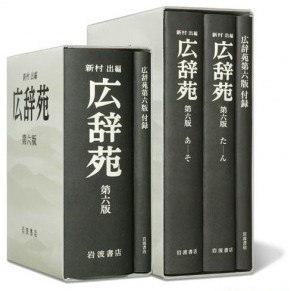
新しい言葉 (New Words) by Alex Dodge: A method for generating phonetically unique words from a corpus of existing words in the Japanese language. —resulting in words that are statistically similar to Japanese.
Read More
新しい言葉 (New Words) by Alex Dodge: A method for generating phonetically unique words from a corpus of existing words in the Japanese language. —resulting in words that are statistically similar to Japanese.
Read More“
“Farewell To The Feminine Hand”
“It was the day before my daughter’s high school graduation and I thought I’d treat her to a manicure at ___’s so she could pick up her summa cum laude diploma with pride. Imagine her mortification when the manicurist commented on her OUTSIZE THUMBS, and declared that painting such monster digits would cost double. Whysoever could this be? I had to investigate. It turned out that my daughter – the most popular girl in her class – had been sending up to 300 text messages – short notices on the mobile phone – per day. While glad she was so very socially-engaged and supportive of her friends, this one-handed work-out had quite destroyed the elegance of her former elegant pianist’s hand…”
” Jay @hautepop 2:51 pm on December 8, 2012. Intriguing irony here.
-
A patent for an “Internet refrigerator and operating method thereof” by peeps at LG Electronics: The Internet refrigerator includes a modem for performing a data communication with remote communication devices through the Internet, a first contr...
Read More“Motor cells that respond to the sight of other people moving are intriguing, there’s no doubt. It’s likely they play a role in important social cognitions. But to claim that they make us empathic, and to raise them up as neuroscience’s holy gr...
Read MorePierre la Police, So Foot (2012):“In 2050, soccer will be totally different / First: we will not call it “le foot” but ‘spetnos’” “Every game will be played at the Olympa [a concert hall in Paris]” “It will look like a “yes/no game...
Read MoreFootbrawl Quest: a turn based football game featuring the Knights vs the Undead.
Read More“The project has five main points:1. Opposition to dead media. Media never dies, it decays and rots, and is reformed and remixed but always “stays as a residue in the soil”. 2. Opposition to planned obsolescence, which is an “unsupportable dea...
Read More“The New Aesthetic has been repeatedly and roundly criticised for not stating itself clearly in a way that old frameworks, artistic and academic, may get their heads around; but also for romanticising “robots”, a fundamental misunderstanding of t...
Read More“Two major issues appeared yesterday. One is the sustainability and durability of research projects originated as “just-in-time” ones. Rapid response papers are necessarily imperfect or incomplete, precisely because they need to be put together i...
Read MoreSMB Pastel, made with Alien Skin’s Snap Art photoshop plugin.
Read More“Odds are that your imagination will be adding things to the present world. I am sorry, but this approach is exactly backward: the way to do it rigorously is to take away from the future, reduce from it, simply, things that do not belong to the comin...
Read More“We very quickly got stuck in a kind of quicksand about whether and why we were promoting a questionable form of lo-brow and generally crap consumerism. Were we simply doing a classic client-services design exercise or were we trying to perform a pol...
Read More“the flip-flop (n.) the process of pushing a work of art or craft from the physical world to the digital world and back again—maybe more than once That’s pretty abstract. Here’s an example recipe:
1. Carve a statue out of stone. PHYSICAL 2. D...
Read MoreProbably the most interesting use case for Augmented Reality: Sudoku grabbing, via @iamdanw
Read More“We have this incredible fetish for youth. I want to laugh. Of course young people are using technology: their parents are paying for it! That’s like saying I took my children to a buffet and they ate themselves silly. As soon as they start paying ...
Read MoreIt's the second year I am teaching the HUM-401 class at EPFL with Daniel Sciboz. The course is about creative processes and tricks employed by designers in their work. Our aim is to show engineers from various areas (IT, biology, chemistry, material sciences, architecture) a different approach than the one they have through various means: short lectures, basic assignments and crits. The first semester is devoted to techniques and methods, and the second semester corresponds to a personal project. This course is extremely refreshing for me as it allows to understand the various frictions between "designerly" of doing. I blogged about this last year here and this new class will have will certainly lead me to new findings. One of the most interesting moment of the first semester is the prototyping phase (which follows the observation and the ideation series of sessions). More specifically, there is course devoted to "quick and dirty prototyping" that we always try to renew, finding original ways to make students understand the relevance of iterating their ideas via basic techniques. The class starts off with a short intro about the underlying rationale to prototyping:
The idea that mock-ups to test things not only in talk but also through richer bodily, social and contextualized interactions, is easily grasped by the students but not necessary easy to put in place. This is why we then apply these ideas with two exercises.
Exercise 1: the post-it phone
This design exercise is a common assignment in design schools and I found some inspiration at at CIID about how to apply it:
"Students worked in teams of three to imagine new mobile interaction scenarios around a theme/context. Each partner applied a stack of twenty or so post-it notes to the screen of their personal hand-held and draw interface states on each. As the interaction scenario was acted out, the notes were peeled off as the reciprocal actions unfolded."
Our brief was the following:
"Form a team of 2 persons. Each team has to imagine a new mobile service based on the results of your field study (observation/interview): a map/orientation app. Using a stack of 15 post-its, you have to prototype the 3 core functionalities of this mobile app. Each post-its represents a screenshot of the graphical user interface (drawn by hand), create a treemap of the User Interface flow and then stick your post-its on top of each others. At least ONE of the feature must be audio!. You have 45 minutes, you will have to present this in front of the class in 5 minutes"

That brief is straight-forward the the exercise went well. It's always hard to have the students role-playing the presentation. Most have the tendency to do a demo (it may be more natural with such an audience) and not to show a real-interaction.
Exercice 2: stickers on boxes
The second exercise uses the marvelous sticker on boxes prototyping toolkit created by Anvil. The materiality of these elements enables to accelerate and improve the sharing and development of ideas in collaborative contexts. It's a set of cardboard, boxes and stickers (with tons of different shapes, interfaces, logo) for for generating objects that communicate ideas quickly and simply:
"The tool currently consists of cardboard boxes in 3 'handheld' sizes, and a sticker catalogue of over 300 different symbols, shapes and icons. From current and past technologies to body parts, we have attempted to make these descriptors cover as broad and comprehensive a range of things as possible. By selecting, arranging and attaching the stickers you can begin to build up a sketch of an object, its potential features and uses."

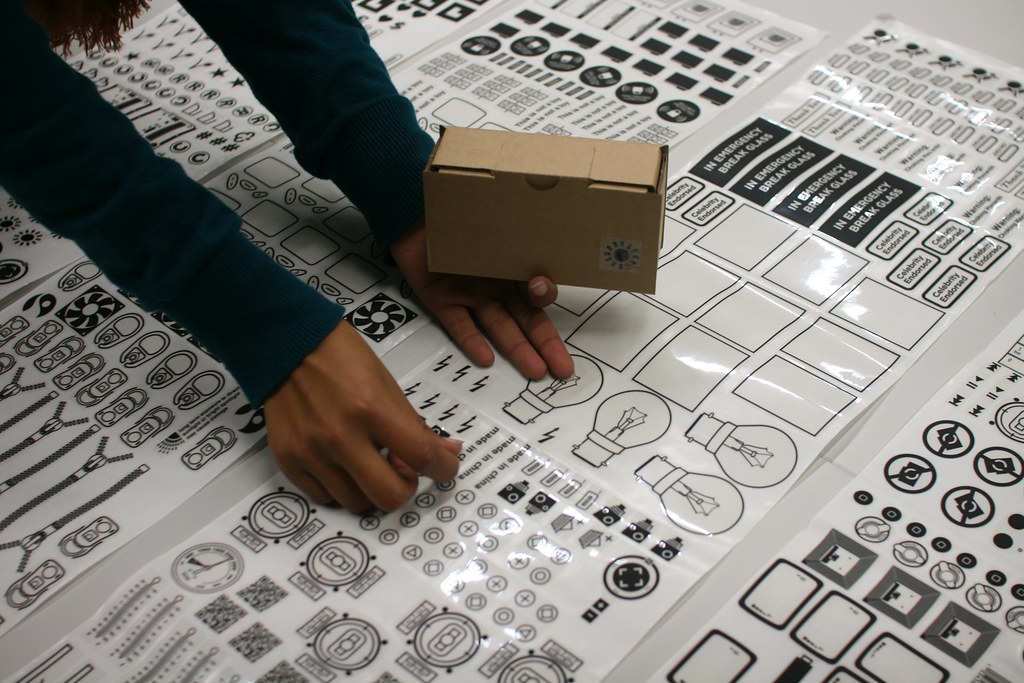
For this part, the brief was the following:
"Same team of participants. Now design a physical mock-up of your project using cardboard shapes and stickers. Create a way to present the use of this prototype in front of the class (role-play). You have 45 minutes, you will have to present this in front of the class in 5 minutes."
See the 5 projects designed by the different groups
Project 1: FYND (Find Your Next Destination)
Context of use: find new places to visit and spatially organize your day.
What it does: the app guides you to the destination you choose (from A to B)

Project 2: Find It Easily
Context of use: during leisure time
What it does: foldable 3D screen on both side of the device, it shows maps and objects's location
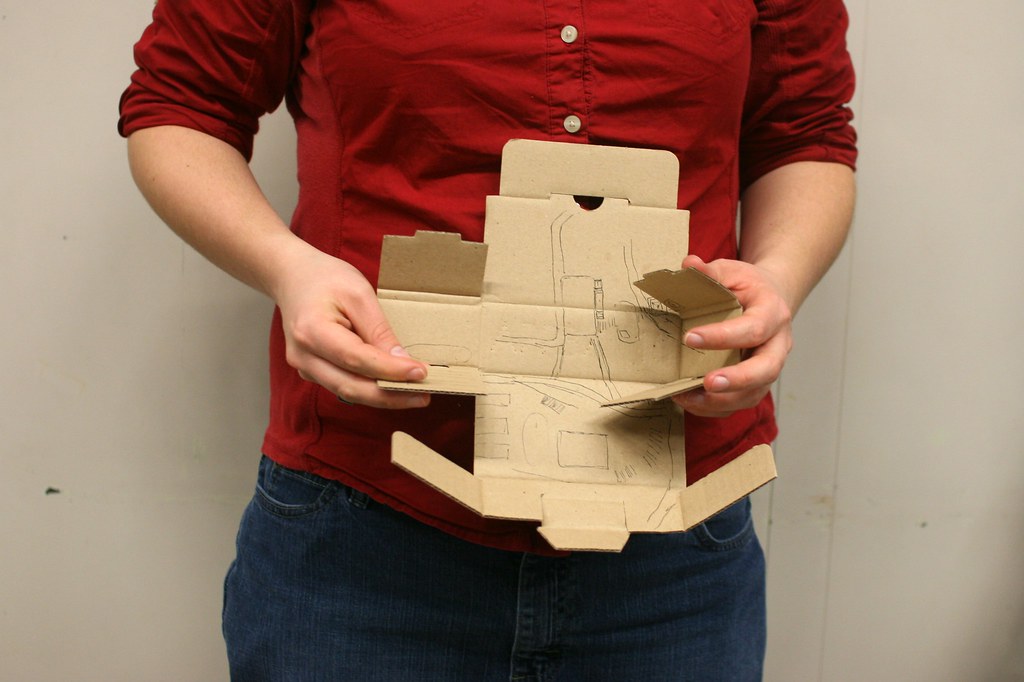
Project 3: To Do Clock
Context of use: daily life/urban environment
What it does: the app allows to create "to do lists" by dragging icons of tasks to a map of the city you are at. The user gets points if he/she gets on time to every places where a todo item is located.
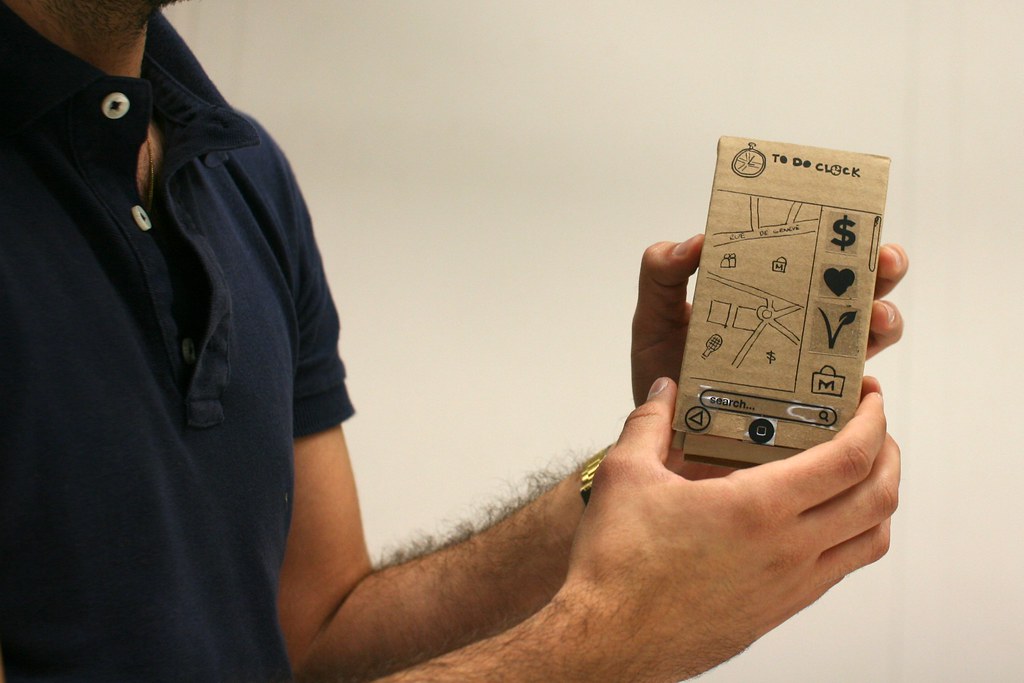
Project 4: GeoCrisis
Context of use: urban street
What it does: a location-based game with a map of where the user is. 3 game modes: survival, capture the flag, and run.

Project 5: Scanline
Context of use: find something (POI, restaurant...) in an urban context
What it does: the service allows to locate you on a map (as well as POIs) by scanning the skyline of the city in which you are located.
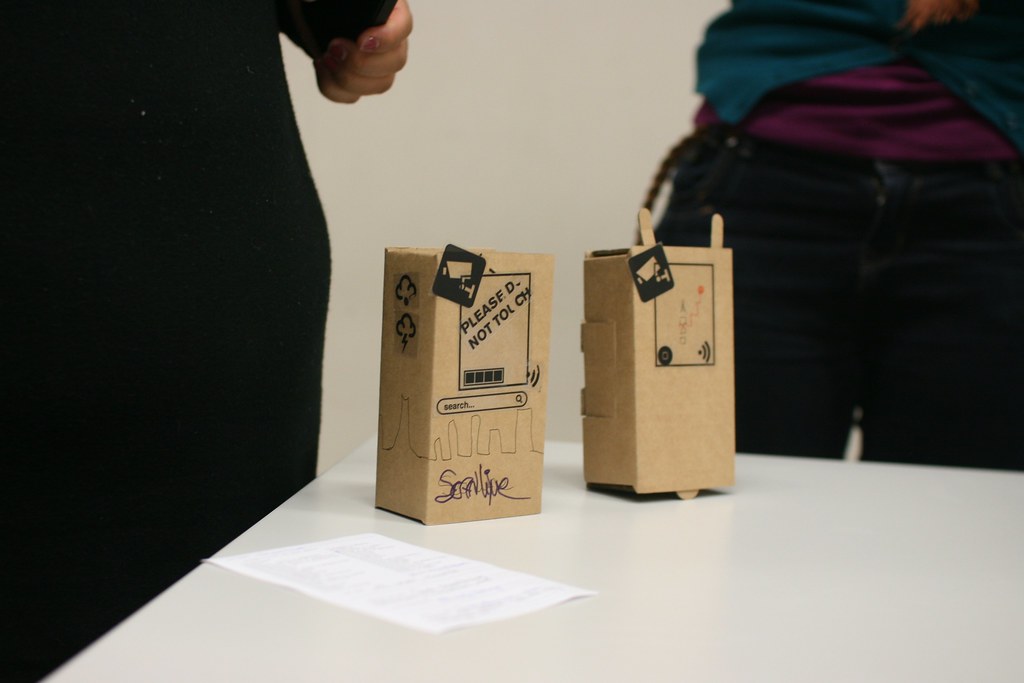
Some comments about the activity:
Why do I blog this? Debriefing the use of new tools is interesting for upcoming workshops.
“Are video games art? They sure are, but they are also design, and a design approach is what we chose for this new foray into this universe.The games are selected as outstanding examples of interaction design—a field that MoMA has already explored ...
Read MoreSeen on “A damn shame art”: Armando M. Diaz first one-man show at the Paragraph Gallery takes the lens of this brave new visual world order as a starting point in presenting the six canvases in this series. The Acrylic on canvas paintings range fr...
Read MoreAfter the Flood has this highly intriguing “Playbook”: The After the Flood Playbook is how we record and improve our methods. The playbook is a catalogue of interchangeable, constantly updated frameworks and processes that can be used to solve any...
Read More